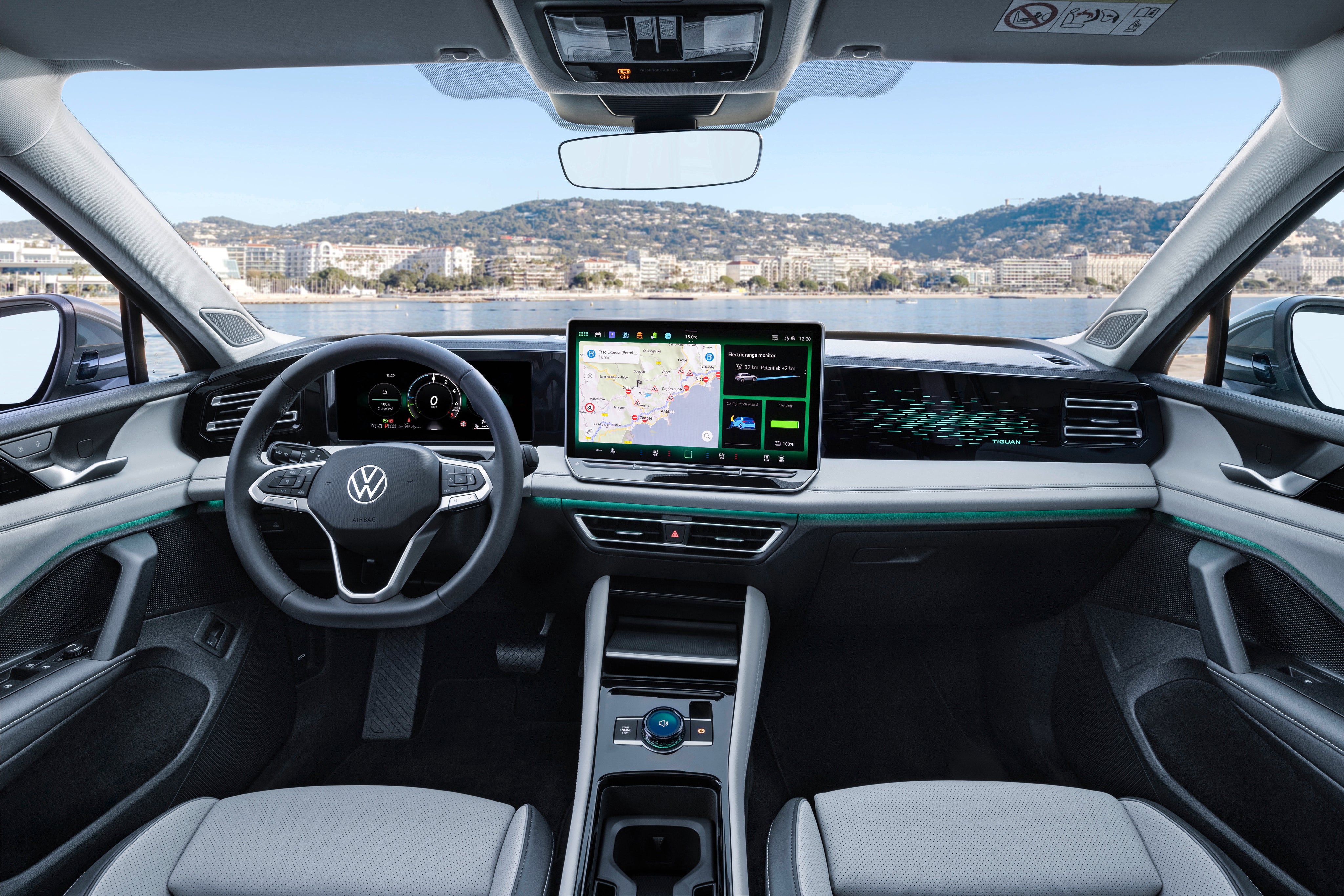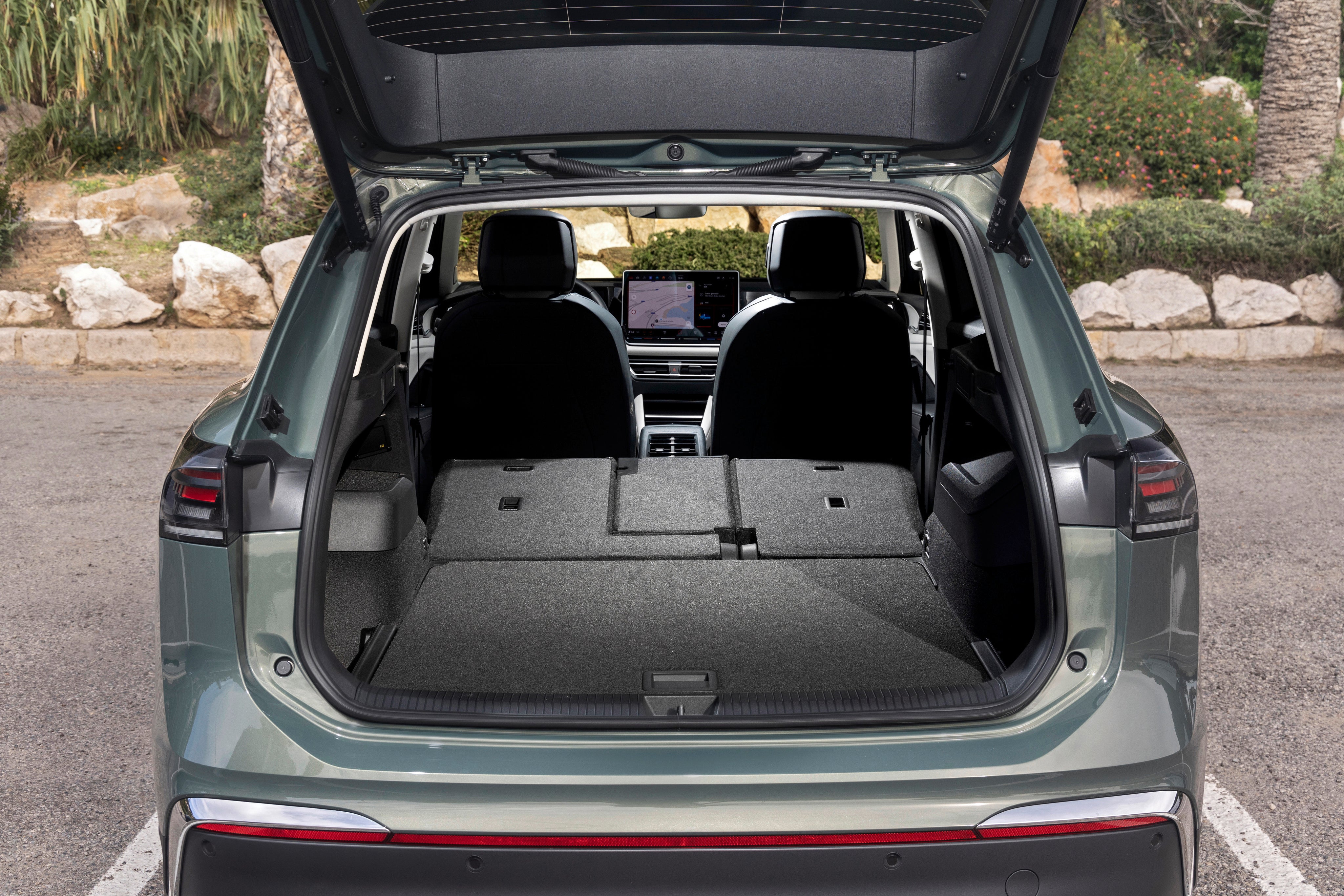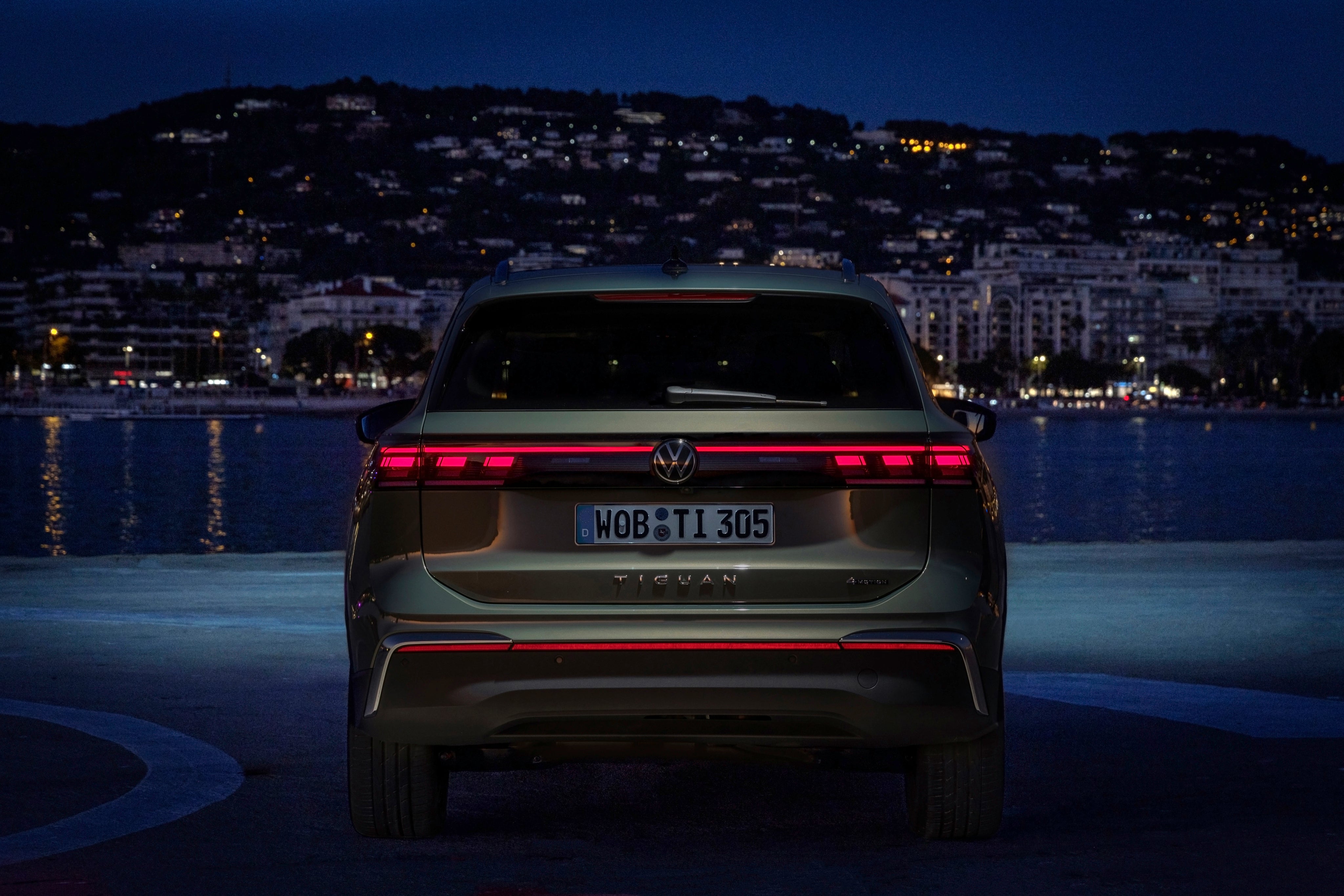
Since its launch in 2007, more than 7.5 million Volkswagen Tiguan have been sold all around the world. It’s VW’s best-selling car – beating even the mighty Golf – and is a regular UK top 10 best-seller. This third-generation version was introduced in 2024, with the range including a long-range plug-in hybrid version called eHybrid.
With a range of 90 miles, it’s far more capable than earlier iterations, and will be a great first taste of long-range pure electric motoring for many. The fuel-efficient petrol engine is there to take over on longer trips, while the Tiguan eHybrid’s ability to use DC rapid chargers means topping up on the move might be an option, too.
There are two flavours of Volkswagen Tiguan eHybrid, either 204hp or 272hp. You don’t really need the full-fat version, not least given its price tag of well over £48k. The regular model is perfectly powerful enough.
Better instead to spend your money on the desirable range-topping R-Line trim. This has a really sporty appearance outside and in, boosting its desirability. Saying that, no Volkswagen Tiguan eHybrid is lacking in equipment; the range opens with high-value Match trim, moving up to posher Elegance and then R-Line. Standard goodies include 3D LED rear lights, electric tailgate, multi-colour interior ambient lighting and three-zone climate control. The illuminated VW roundels front and rear are eye-catching, too.
Compared to the previous Tiguan, the design is more curvaceous and wind-cheating. Volkswagen says it’s 15% slipperier through the air, which helps boost both EV and overall hybrid range. It’s taken a bit of getting used to, but now you’re seeing more Tiguan on the road, it does stand out as a classy, expensive-looking machine.
How we tested
I drove the Volkswagen Tiguan in the sleepy Cotswolds. I covered many miles on twisting, challenging roads, with a large degree of EV driving, and then experienced how it retains enough battery capacity to default into electric mode even with a near-discharged battery as I crawled through the ever-busy town of Burford.
Volkswagen Tiguan: From £42,965, Volkswagen.co.uk

Independent rating: 8/10
- Pros: Long-range plug-in hybrid tech, overall quality and sophistication, great to drive
- Cons: Every version costs more than £40k, key options are also pricey, ride can be firm
Volkswagen Tiguan Specs
- Price range: £42,965-£48,480
- Battery size 19.7kWh
- Maximum EV range: 90 miles
- Engine: 1.5-litre petrol
- Claimed battery & engine range: Over 620 miles
Battery, range, charging, performance and drive
The Volkswagen Tiguan’s healthy 19.7kWh battery gives an EV range of up to 90 miles. For a family-friendly SUV such as this, that’s superb. So long as there’s sufficient charge, it will start each journey in EV mode, so if you want to conserve battery power for later, you need to manually switch it into hybrid mode. User-friendly controls mean this is straightforward; you just need to be mindful of it if you plan to ration use of the battery over a long journey.
DC rapid charging is a welcome addition. It means the Volkswagen Tiguan eHybrid can rapid-charge from 5-80% in just 26 minutes. It’s pretty speedy using a high-power wall box too, courtesy of a standard 11kW AC charger.
If you can’t charge, the engine is generally pretty smooth and refined, so it won’t spoil the peace and quiet too much. 0-62mph performance in 8.2 seconds gives a reasonably eager feel, although it does sound more gruff when worked harder.
The Volkswagen Tiguan is a very mature and premium-feeling car to drive. It has that sense of tireless engineering that you’d expect of a VW, making it feel safe and secure in all conditions. The ride is a bit on the firm side, but it generally copes really well with broken British roads, and settles down to a cruise on the motorway with impeccable refinement. You can also choose an optional DCC Pro adaptive suspension, with fancy two-valve dampers. It’s a really effective system, brining Audi-like sophistication no matter how enthusiastically you’re driving.

Interior, practicality and boot space
The Volkswagen Tiguan eHybrid has that solid, well-built feel you’d expect from a VW. The dashboard has tactile touches and the multi-colour ambient lighting means it looks particularly striking at night.
You’ll have to get used to the gear selector being on the steering column, though; it’s on the right-hand side, where the wiper control normally is. This has been integrated into the indicator stalk instead. It saves space, reckons VW, and makes for a more practical centre console.
I like the seating position in the Volkswagen Tiguan. It’s commanding and gives a good view out. The seats are good – particularly with the optional ‘ergoActive’ seats in top-spec models, They are heated, cooled and include a neat massage function. They’re expensive, at more than £2,200, but if you value comfort, they’re definitely worth considering.
There are no issues with rear seat space or comfort, which is plentiful. The Volkswagen Tayron is the seven-seat sister car to the Tiguan, but you can’t get it with seven seats in eHybrid plug-in hybrid guise, so you’re not missing out there.
The regular Volkswagen Tiguan has an enormous 652-litre boot. Unfortunately, it’s smaller in the eHybrid version, due to the need to accommodate the plug-in hybrid battery. 490 litres is still a decent size though, and it expands to 1,486 litres with the rear seats folded. The load bay is nice and flat with the rear seats folded down too, boosting its practicality, and all Tiguan eHybrid get a power tailgate as standard.
It's a pity a panoramic sunroof is relegated to the options list – and, at more than £1,400, an expensive option at that. The considerably cheaper BYD Seal U DM-i gets one as standard.

Technology, stereo and infotainment
All Volkswagen Tiguan have a 12.9-inch touchscreen display as standard. A 15.0-inch screen is optional, but both run the same MIB4 Volkswagen modular infotainment matrix. The name is a bit jargony but the system itself is excellent, with much more clarity and ease of use than earlier VW infotainment systems. The customisable bar at the top of the display is useful, and climate controls are permanently shown at the bottom, in lieu of physical buttons.
If you upgrade to the larger screen, you can speak commands via the ‘Hey IDA’ voice assistant, which is backed up by ChatGPT. Its greater user-friendliness means there’s less need to rely on this though, while the comprehensive steering wheel buttons are back to being physical buttons, rather than awful touch-sensitive controls. I also like the contextual driver experience switch on the centre console, which has its own tiny colour display – it has the potential to be even more configurable than it currently is. Perhaps Volkswagen will develop it further in time, through over-the-air software updates.
The standard stereo is pretty decent, and you can of course stream music from your favourite smartphone app via Apple CarPlay or Android Auto. I do like the optional Harman Kardon premium sound system though, which helps make the most of the Tiguan eHybrid’s refinement. It is a bit premium-priced though, at almost £1,500, but then it needs to be powerful, to fill the Tiguan’s roomy interior with sound.

Prices and running costs
Volkswagen Tiguan eHybrid prices start from almost £43k, and rise to nearly £46k. That looks steep, when you consider that a BYD Seal U DM-I is priced from £10k less. Its 78-mile range isn’t far off the Tiguan, either. Saying that, the Volkswagen Tiguan eHybrid is closer in price to more established rivals such as the Skoda Kodiaq, Kia Sportage and Peugeot 3008.
The long electric range of the plug-in hybrid battery will mean plenty of pure electric miles for those who can regularly charge up. The 1.5-litre turbo petrol engine is efficient too, which should help with running costs. The Volkswagen Tiguan also enjoys very strong retained values, although insurance ratings are five or six groups or so higher than the non-hybrid eTSI versions.
Volkswagen Tiguan rivals
- BYD Seal U DM-i
- Skoda Kodiaq
- Kia Sportage
FAQs
How long does it take to charge?
The Volkswagen Tiguan can charge from 5-80 per cent in just 26 minutes using a 50kW DC rapid charger. It’ll take around two and a half hours to reach 100% via 11kW AC charging.
How much does it cost – is it worth it?
Every Volkswagen Tiguan eHybrid costs more than £40,000, but the long electric range and premium feel do help justify it.
Does Volkswagen replace batteries for free?
The Volkswagen Tiguan eHybrid has an eight-year, 100,000-mile warranty for its high-voltage battery.
Why trust us
Our team of motoring experts have decades of experience driving, reviewing and reporting on the latest EV cars, and our verdicts are reached with every kind of driver in mind. We thoroughly test drive every car we recommend, so you can be sure our verdicts are honest, unbiased and authentic.
The verdict
The Volkswagen Tiguan is a well-loved family SUV that’s a regular top 10 best-seller here in the UK. The latest version offers an impressive eHybrid plug-in hybrid version, that is one of the front-runners in a competitive sector. It could be the perfect introduction to electrified motoring for many.
Kia Niro review: Compact plug-in hybrid is a practical all-rounder
Jeepers creepers! Has the Grand Cherokee gone all soft on us?
Best used electric cars 2025: Top 10 second-hand EVs to buy
Best electric cars 2025: Top 12 EVs to buy
Used electric vehicle sales surge to new record high
Geely EX5 review: Sensational value SUV with a little help from Lotus
Hyundai Ioniq 6 N review: The sports car for the PlayStation generation
10 best cheap electric cars: Affordable EVs worth ditching petrol and diesel for







